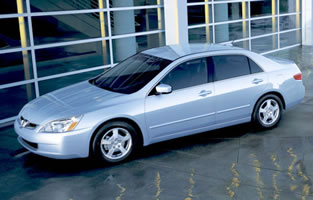By Peter Valdes-Dapena, CNNMoney.com staff writer
NEW YORK (CNNMoney.com) -- When my neighbors learned the car I was test-driving was filled with compressed natural gas, the first question many asked was about safety.
"Gasoline is flammable, too, you know," I reminded them.
In fact, compressed natural gas is supposed to be safer than gasoline. In the event the tank is punctured, the escaping gas would rise into the air away from the car, as opposed to puddling on the ground like gasoline.
And the tank on the car I was driving, the 2006 Honda Civic GX, is considerably thicker than one on a standard car. The Civic GX is currently the only natural-gas car.
Once you get past the safety issue, there are four major advantages of compressed natural gas as a motor fuel.
First, it's much cleaner-burning than gasoline. The tailpipe emissions from a Civic GX make a regular economy car seem like a diesel bus.
Second, it can be slightly more fuel-efficient than gasoline. The Honda Civic GX gets 39 miles for every gallon-equivalent of natural gas. (Gallon equivalency is based on the amount of energy contained in one gallon of gasoline.)
Third, natural gas is cheaper than gasoline. According to EPA estimates, the gallon-equivalent of natural gas costs about 70 cents less than a gallon of gasoline. Unlike gasoline, natural gas comes out of the ground just the way you use it, no refining needed, which is one factor that helps keep costs down. The only thing that gets added is a funny smell so you can tell if it's leaking.
Finally, natural gas is an almost entirely domestic product. Nearly all the natural gas used in the United States comes out of the ground here. Some is piped in from Canada. A small amount, called landfill natural gas, is collected from our nation's rotting garbage.
The annual fuel cost for a Civic GX is just $681, according the EPA estimates. A year's worth of gasoline for a regular four-cylinder Civic with a manual transmission - the GX has an automatic - would be $986.
The car itself, thanks to a $4,000 tax credit from the federal government, costs little more than a regular four-cylinder Civic.
Fueling the car involves a bit more finesse and arm strength than pumping gasoline. You have to line the big hose nozzle up with the little car nozzle then flip a lever to seal the connection. When I finished filling the GX and started to pull the hose out, I was unprepared for the little kickback which made me bang the nozzle against the side of the car.
Otherwise, the
Why natural gas may not be for you
So why shouldn't you just rush out and buy one of these for yourself?
The first reason would be that you probably can't. The Civic GX is available for retail sale to the public in only two states, New York and California.
It's available for fleet sale everywhere though, and that's how most Civic GX's are sold. And that's where they make the most sense, in situatuions where they're driven around locally all day and returned to the garage for refueling each night..
"If you've gotten a parking ticket in Washington D.C., it was from someone driving a natural gas Civic," said Barry Carr, a consultant who works with Honda on Civic GX marketing. (If that doesn't endear the car to you, what will?)
For big fleets, the GX is inexpensive to run and, unlike a hybrid car, it qualifies as an "alternative fuel vehicle" under federal clean-air rules, said Carr. (Hybrid cars don't qualify because they run on gasoline. They do qualify for some state benefits for fleet buyers, though.)
If you drive any sort of alternative-fuel vehicle you need to plan ahead, though. There are about 1,000 publicly accessible natural gas filling stations nationwide. That means there are probably very few close to your home or to anywhere you want to go.
To further complicate things, the car holds only about 7.2 "gallons" worth of compressed gas, which is good for a range of 220 miles. That's about half the range of a gasoline-powered Civic.
Honda can help you out there, though, by hooking you up with a Phill. That's an at-home natural gas pump that runs off your home gas supply. It's a low-pressure device that takes 12 hours to fill a tank from empty. But if you plug your car into it every night you should be able to keep your tank filled most of the time.
Finally, there's the trunk space. Gas takes up more space than liquid. And to squeeze a usable amount into your car, the gas has to be compressed to something like 3,600 PSI. To contain that kind of pressure, the Honda GX's fuel tank, hidden behind the back seats, is shaped like an enormous propane tank.
That squeezes out trunk space, leaving the car with just six cubic feet. That's enough for everyday errand running, but not much else.
Most individual GX buyers, said Carr, already have another car. The GX is just their "city car" or used as a commuter vehicle. That way it can snuggle up at home with its Phill each night.
For most environmentally conscious car buyers, the
The Civic Hybrid's resale value will probably be much better than the GX, said Eric Ibara, director of market valuation for Kelley Blue Book. The GX's limitations combined with the relatively large number that will eventually be turned out from corporate and government fleets should combine to make the GX a tough sell in the used-car market.
Finally, since the
We could hope for the fueling infrastructure to catch up making a car like the Civic GX more useful to ordinary citizens. But since there seems to be little real advantage compared to gasoline-powered hybrid technologies already available, natural gas seems likely to remain a "fleet only" option for the time being.


